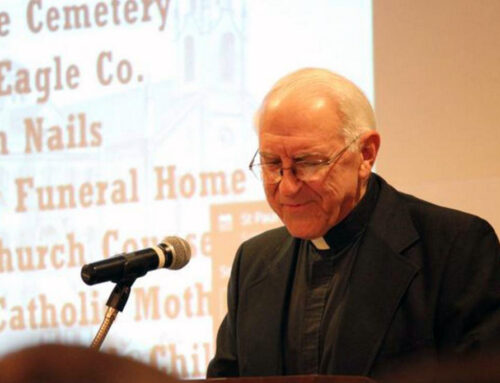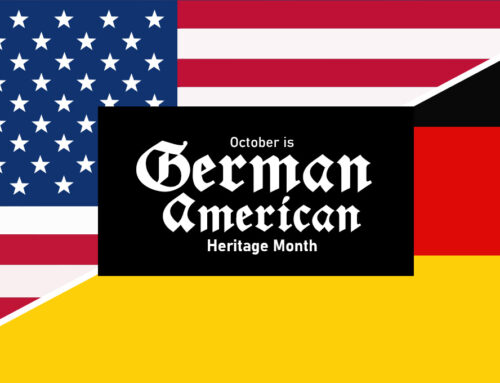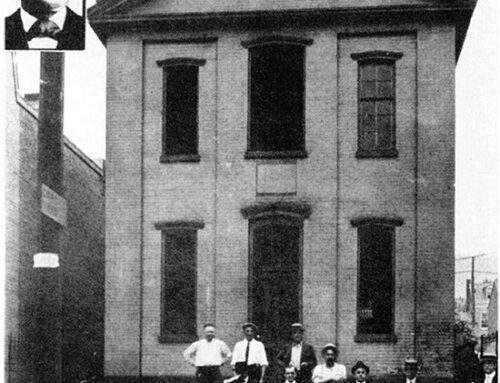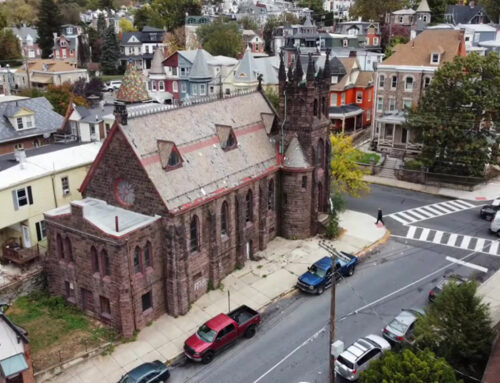George Bornemann was born October 5, 1838, at Lingen, Province of Hanover, Germany. His father was a rope-maker; his mother, Louisa (born, Rolfs) died when he was six years old.
The schools of his native town provided his elementary education, and he early manifested a vocation for the priesthood. Inspired with missionary zeal, his thoughts turned to America, and he determined to prosecute his theological studies among those for the salvation of whose souls he intended to devote his life. Accordingly, he embarked, unaccompanied, on a sailing-vessel, leaving Bremen, July 4th, 1854, and landed in New York on the Feast of the Assumption.

Upon his arrival he joined an older brother who had preceded him to this country, and was living in New York City. He remained there a short time and then left for St. Vincent College, Beatty, Pennsylvania, in charge of the Benedictine Order, where he completed his classical course.
In 1862, he removed to the diocese of Philadelphia, and entered the theological seminary of St. Charles Borromeo, then situated at 18th and Race Streets, Philadelphia. Here he was ordained to the priesthood by Rt. Rev. James F. Wood, Bishop, (later Archbishop) of Philadelphia, on June 22, 1865.
Father Bornemann, after celebrating his first High Mass at St. Alphonsus Church, New York City, was assigned as curate to the Church of the Assumption, Philadelphia, whose rector was Very Rev. C. J. H. Carter, V.G.
After a year of this service he was named pastor of St. Peter’s Church, New Castle, Delaware, to which were attached the missions of Delaware City, Newark, Smyrna, Harrington, Frederica, and Fort Delaware, at which last name place he served as Catholic chaplain.
Fort Delaware was not new ground to him, for as a seminarian he had gone there with Bishops Wood, O’Hara and O’Connor to look after not only the Union soldiers, but the Confederate prisoners who numbered over one hundred thousand, including more than three thousand officers, many of them of highest rank, and had many interesting experiences.
Meanwhile, in 1862, the year during which Father Bornemann (then a theological student) had come into the diocese, St. Paul Parish, Reading, was organized, with Rev. Schrader as its pastor. The latter labored at St. Paul Parish until 1865, when he was succeeded by Rev. G. Wallmyer who remained until his death, of typhoid fever, in February, 1867. The vacancy thus created was filled by the appointment of Father Bornemann who came to Reading the same month.
Upon his arrival in Reading the young pastor found little to encourage, and much to daunt him. His people, few in numbers, were not possessed of worldly goods, and the financial situation was a critical one. But they were rich in the priceless gift of Faith; and together, priest and people faced the future with serene courage.
From the first, Father Bornemann, a staunch advocate of parochial schools, set to work to organize a school, which was held in the basement of the church, and was conducted by laymen.
In 1869 he began the erection of a school building, which was completed, and dedicated by Bishop Wood, in the Fall of 1870. Meanwhile the parish had increased greatly, numbering about three thousand souls; and the school was opened with almost four hundred pupils. Father Bornemann was fortunate enough to secure, as teachers, the Sisters of Christian Charity, who had come to America from Germany and established themselves at Wilkes-Barre, Pennsylvania.
In 1869 the church was enlarged from 60 x 120 to 60 x 162 ; and a steeple was raised to a height of over two hundred feet. A chime of bells was later installed in 1879. A new rectory next engaged the attention of Father Bornemann built in 1871.
In the last-named year Professor Erasmus Duppuis was engaged as organist and teacher of the higher grades in the school.
Realizing the city’s need of a general hospital, Father Bornemann took the matter under consideration. His resolution was quickened by the severe small-pox epidemic of 1872.
He, therefore, purchased a two-story dwelling at the northeast corner of Walnut and Birch Streets, and started St. Joseph’s Hospital under the care of the Sisters of St. Francis. Through all its changing phases Father Bornemann planned and counselled. He gave generously of money. He gave (more valuable still) his time, his judgment, his indomitable spirit. To all details, great and small, he devoted careful consideration and unsparing energy.
Below: St. Joseph’s Hospital, 1873.

During the recurrence of the plague in 1893, Father Bornemann, at the request of the Board of Health, had a large building on the premises turned into a pest-house. Not satisfied with contributing largely to its cost, he assisted with his individual labor in preparing the building for the reception of patients – of whom over six hundred received attention there during the epidemic.
Fearing the consequence of maintaining, as a permanency, such a place near the general hospital, he persuaded the county officials to erect a building for the care of contagious diseases, near the County Home. During the continuance of the plague he was a daily visitor at these places, bringing help to those in charge, and bodily and spiritual consolation to the sufferers from the dread disease.
In 1882 Father Bornemann had a convent erected for the Sisters of the parochial school; a large annex to which was built ten years later. In 1907 he rebuilt the parochial school at a cost of nearly $25,000. At the same time he installed a hot-water system for heating church, school, rectory, convent and orphanage.
During these years the parish had grown beyond the accommodations of the church; and the building was entirely reconstructed, its dedication by Archbishop Ryan taking place in May, 1885.
Actuated by unceasing interest in the welfare of his people, Father Bornemann purchased, in 1889, several properties adjacent to the church, and founded an orphanage for boys. From 1889 to 1900 the first floor of this building was used as a free dispensary which after the last-named year was transferred to St. Joseph Hospital.
Busy as was Father Bornemann in the myriad affairs of his parish and the institutions he had started therein, his charitable efforts were not circumscribed by parochial limits. In 1889 the property at Fourth and Pine Streets, was purchased by the House of the Good Shepherd. This institution having rapidly outgrown its quarters, was moved to Glenside, here, upon land donated by Father Bornemann, a new building costing $180,000 was dedicated by him on June 21st, 1900.
Below: House of the Good Shepherd.

On June 22, 1890, Father Bornemann celebrated the Silver Jubilee of his ordination at a Solemn Pontifical Mass, at which several of the hierarchy and large numbers of the clergy were present. In the evening he was escorted by the various Catholic Societies of the city to the Grand Opera House where a reception was held, at which addresses were made by some of the members of the congregation, and by George F. Baer, Esq., a warm personal friend. On this occasion he was presented with a costly set of vestments.
Father Bornemann took but little respite from his labors. However, in 1872, and again in 1900, he visited Germany. Before the last-named trip a farewell reception was tendered him in church; and a handsome sum of money was presented him for the expenses of his trip. His return was made the occasion for an outpouring of his people, who met him at the station, and with great joy escorted him home.
Imbued with profound affection and admiration for his native land, its customs, and its ideals, Father Bornemann had always close to his heart the welfare of his fellow-countrymen who settled in America. He helped actively to found the Leo House, in New York, a place to protect German immigrants and to aid them in finding employment.
He was, also, for many years, a Commissary of the priester – Verein; and in that capacity was instrumental in organizing, and conducting large German Catholic Congresses in Cleveland,, Pittsburgh, Newark, Buffalo, Louisville, Detroit, Chicago and Milwaukee. These meetings were productive of great good, and were attended by leading Germans of America and abroad, including Dr. Ernst Lieber, who led the Centre Party in Germany after the death of Dr. Windthorst.
In 1895 he purchased a farm of fifty-two acres located in Muhlenburg Township for burial purposes. This he developed and improved, blessed the new ground as a burial place, and gave it the name of Gethsemane Cemetery. As Gethsemane Cemetery was to become the burial place for practically all Catholic parishes of Reading, Father Bornemann in his foresighted wisdom, procured additional farms surrounding the cemetery.
Below: Gethsemane Cemetery.

Since the early years of the arrival of Polish and Slavonic peoples in Reading, Father Bornemann had been their warm friend and helper. He had supervision of them during the critical formative period of their settlement, and their assimilation with American methods and ways of life, both of Church and State. He guided them wisely; and they, in turn, trusted him implicitly.
He looked after the building of the Polish Church at Twelfth and Spruce Streets; and of the Slavonic one at Oakbrook. In July, 1914, he dedicated the successor of the latter, —the handsome church of Saints Cyril and Methodius at Sixth and Laurel Streets.
He also, materially assisted the Bernardine Sisters (Polish), to build the novitiate and orphanage at Oakbrook, which they erected at a cost of over $100,000.
The Italians, too, claimed his interest. In 1904 he purchased a church building at Schuylkill Avenue and Green Street, and turned it over to them as The Holy Rosary Church.
In 1913, at an individual expense of almost $20,000 he bought and renovated a former public school building at Third and Franklin Streets, and saw it opened as a parochial school for Italians.
Below: Original Holy Rosary School.

Ever in quick sympathy with all sorts and conditions of the sick and afflicted, Father Bornemann has been specially interested in the fight against tuberculosis.
The large and handsomely furnished Neversink Mountain Hotel, built and equipped at a cost of $125,000, having proven a failure as a Summer resort, Father Bornemann became its purchaser in 1905, aided by the kind offices of George F. Baer, Esq., who had a large interest therein. It was his intention to equip it as a sanitarium for the treatment of indigent sufferers from tuberculosis. He had in further prospect the purchase of an adjoining farm from which to provide requisite supplies.
Below: Neversink Mountain Hotel.

Unfortunately, just on the eve of the completion of these arrangements, the hotel was entirely destroyed by fire; and the plan was necessarily abandoned. Large supplies of bedding and table linens, which were purchased with the hotel, and which were in the process of laundering in the city, were divided into four equal shares, and donated by Father Bornemann to St. Catharine Orphan Asylum, Home for Friendless Children, St. Paul Orphan Asylum, and the Home for Widows and Single Women.
He later donated the 17 acres of land on which the hotel had been erected, to the Berks County Tuberculosis Society, to be used in connection with its work.
St. Michael Seminary, Hyde Park, which was founded in 1894, as a boarding-school for girls, under the provisions of the will of Henry Felix, having some years later been abandoned for that purpose, was taken over by Father Bornemann in the interest of a further fight against the White Plague.
At a cost of over $30,000 (advanced wholly by himself) he changed it into an admirable sanitarium for such members of the various female Religious Orders of the Church, as might be afflicted with tuberculosis.
Other arrangements having subsequently been perfected to care for such afflicted ones, he turned the building over to the Missionary Sisters of the Sacred Heart, with headquarters in Germany, and who use this beautiful place as a mother-house in America.
Below: Convent of The Sacred Heart.

He, also purchased an adjoining farm, which was transferred by him to the Missionary Fathers of the Sacred Heart Order, who established a seminary there.
Kindred zeal had led him to take up the matter of Catholic services in the magnificent State Sanitarium newly opened at Hamburg, this county. He was the first priest to say Mass there.
In this connection, he (at his own expense) rebuilt St. Mary Church, Hamburg, (which had been abandoned upwards of thirty years), and making of it a credit to the diocese.
Notwithstanding that Father Bornemann was at all times modest and unassuming; that he shrank from public recognition; and that he let not his left hand know what his right hand did by way of charity, it was inevitable that the magnitude of his work and the extent of his benefactions should be recognized and rewarded by his ecclesiastical superiors.
In 1884 he was appointed Secretary of the Commissio de Fide in the Provincial Council held at Philadelphia. The same year he was named Permanent Rector of St. Paul Church. In 1886 he was placed upon the Diocesan School Board, then first organized.
Upon the recommendation of Archbishop Ryan, Father Bornemann was, in 1910, elevated by His Holiness Pope Pius X to the rank of Domestic Prelate, with the privilege to wear the purple, and to the title of Monsignor.
The solemn ceremony of investiture took place Monday, March 28th, at High Mass, at which Most Reverend Edmond F. Prendergast pontificated,—his predecessor, Archbishop Ryan, having died after the nomination of Monsignor Bornemann.
Right Reverend Kodelka, Co-Adjutor Bishop of Cleveland, and an old friend of Monsignor Bornemann, preached the sermon. The Rt. Reverends John W. Shanahan, Bishop of Harrisburg, and Leo A. Haid, of Belmont Abbey, Bishop of North Carolina, were also present; as were large numbers of the clergy, including priests who had been ordained from St. Paul parish. In the evening a reception was given Monsignor Bornemann by his parishioners, at which he was presented with a large sum of money, and a handsome sanctuary-chair.
In 1913 Monsignor Bornemann, now senior priest of the diocese, was named Rural Dean of Berks County.
Monsignor Bornemann, or, as his people know him best, Father Bornemann—has been a true father to his people. Devoted to their welfare, spiritual and temporal, upwards of forty-eight years, he has entered into the lives of successive generations as it is given to but few priests to do.
Msgr. Bornemann, who was the beloved rector of St. Paul’s for fifty-six years was called to his eternal reward at the age of eighty-five. His death, attributed to ailments incidental to advanced age, came after a confining illness of several months. On March 3, 1924, his death brought sorrow to the members of the parish and to all the city of Reading. Msgr. Bornemann was buried March 8th, with a Solemn Requiem Mass at which Cardinal Dougherty presided.
The Monsignor Bornemann Chapel in Gethsemane Cemetery was completed in 1930. A Solemn Requiem Mass was celebrated by Father William Hammeke for the late Monsignor Bornemann, in whose memory the beautiful mausoleum had been erected. The body of Msgr. Bornemann, which had been buried in the cemetery, was transferred to the mausoleum where he now rests.
Description of Monsignor Bornemann Memorial Chapel

The Monsignor Bornemann Memorial Chapel of Gethsemane Cemetery is of Roman architectural design and is thirty by sixty-five feet, built entirely of Indiana limestone, with monolithic concrete roof chiseled to a granite finish. The covering of the roof is sheetlead, all metal parts being non-ferrous. Eight monolithic columns mark the entrances supporting a limestone ceiling.
Two solid bronze doors give entrance to the mausoleum. The interiorcontains marble Priedieus which face the altar, fifteen crypts beneath the floor and covered with individual limestone slabs, and a lime- stone altar. The chapel and crypts are built with a modern ventilating system in accordance with the requirements of the State Health Department. A large stained glass window, located over the altar, gives natural sunlight for the chapel. This large window, together with the other windows in the rear of the chapel, were designed in the J. M. Kase studios, by Paul G. Kase, and represents St. John’s vision on the island of Patmos as described in the Apocalypse, the central and principle medallion representing his vision of Our Lord seated among the seven candlesticks and the seven stars shows Him with a book of the seven seals in his hand. The Golden City is seen in the background and in the uppermost portion of the window, the dove representing the Holy Spirit is found. The composition is framed in small medallions, representing the Bishop of the seven churches of Asia. On either side of the main entrance, in the rear of the chapel are two small, but very beautiful windows representing a worshiping angel with a censer, and another angel of Judgment holding the scales of Justice.






Leave A Comment